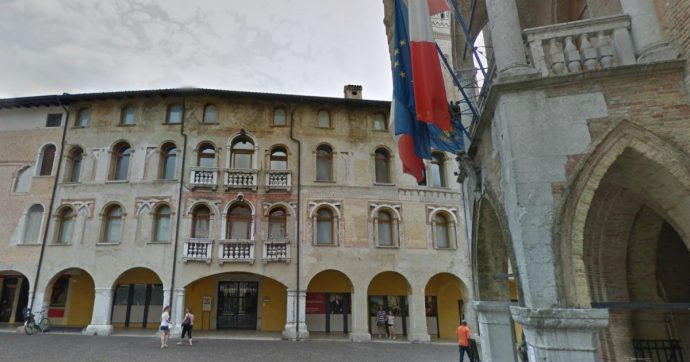



The territory around the Noncello river, considered between 900 and 1200, extended for about 200 square kilometers. It included the settlements that today correspond to Cordenons, Vallenoncello, Torre, Corva, Villanova, Fiume Veneto and, further on, Zoppola, San Foca and San Quirino.
Pordenone (in the Latin Portus Naonis) is mentioned for the first time in 1204 in the Travel Diary of Wolger of Passau, future Patriarch of Aquileia.
Between 1000 and 1200 the small territory was coveted by the Patriarchate of Aquileia, by the Counts of Gorizia, by the Marca Trevigiana. Having become the domain of the lords of Carinthia, it passed to those of Styria (1269) and, in 1276, it finally became a possession of the Habsburgs of Austria.
In a short time the original nucleus became the reference point of the surrounding minor villas; possesses ecclesiae; it imposes a wetsuit - a duty, that is to say - to be paid for port traffic on the Noncello river; it is governed by a capitaneus, by the massari.
During the thirteenth century the first important and significant buildings that still exist were also built: the Cathedral with the Bell Tower and the Palazzo del Comune, protected by a first circle of walls.
In the second half of the century the castle was built by the Austrian rulers, isolated on a hill overlooking the river. In 1278 the ecclesia Sancti Marci became a parish.

At the time of the granting of the so-called Habsburg Proto-statute of 1291, a domus communis already exists, a building for meetings where representatives and elders meet for the management of the Community. The use of its own coat of arms was granted as early as the early decades of the fourteenth century: a crenellated portal open to the waves of the sea, on a red background with a silver band.
The city becomes the transit point of a road that connected the Venetian territories (through the Livenza, Meduna and Noncello rivers) with the northern transalpine regions (through the centers of Cordenons, Spilimbergo, Gemona, Pontebba).

The center has a fairly quiet development both in construction and as a political and administrative reality, remaining the possession of the House of Austria within patriarchal domains. The imperial captains reside in the castle, representing military power.
Pordenone is a castle, in the homeland of Friul, […]; and there is a Cap. ° […] and who lives in the castle which is very strong; et Pordenon is very beautiful, full of caxes, with a very long road, one enters through one door and one through the other; goes longo. He is the protector of San Marco ... Here ... is a beautiful loza (loggia) et piaza ...
So writes Marin Sanudo in his Itinerary for the Venetian mainland of 1483.

It remained the property of Austria until 1508: the city and port continued to develop.
Then also Pordenone, which remained a corpus separatum in Friuli which was already subject to Venice at the end of the second decade of the 1400s, became the domain of the Serenissima, the winner in the conflict with Austria. The city was granted as a fief to General Bartolomeo d’Alviano (1455 - 1515), a man of arms of Umbrian origin. The d’Alviano family remained the lords of Pordenone until 1537, the year which marked the definitive passage under the direct rule of Venice, which reconfirmed the validity of the ancient statutes and privileges of autonomy, codified since the thirteenth century.
A new period begins which coincides with moments of economic and demographic development. In the early sixteenth century the inhabitants amounted to over 1500; in the middle of the same century there were 2700 residents. In 1588 the inhabitants, despite a serious plague epidemic which occurred in 1576, rose to 7000 units, so much so that the parish of San Marco was split in two, also constituting the parish of the church of San Giorgio , located in the upper Borgo.
1500 is a golden century for the city. Cultural life reaches its maximum splendor: Academies and Cenacles rise. The major buildings in the historic center, which still exist today, are built or expanded and the noble families (Ricchieri, Mantica, Rorario) compete to compete for the hospitality of painters, humanists, writers and poets.

The following period represents above all the affirmation of the entrepreneurial spirit; the number of mills, factories, production activities (metals, wool, paper) increases, a prelude to industrialization that culminated in the nineteenth century, until 1797 Pordenone remained, together with the rest of Friuli and Veneto, in Venice. With the fall of the Serenissima Republic, a few years of alternation of domination began between the opposing Franco-Italian and Austro-Russian alignments.
From 1805 it became the capital of the French Noncello District; with 1815 it passes to the Lombard-Veneto Kingdom which it governs until 1866 when, with the third war of Independence, it becomes definitively Italian.
In the meantime, the city is characterized by an authentic industrial take-off in the textile, ceramics and paper sectors, thanks also to the advent of hydroelectric energy used in Pordenone as early as 1888. Since the first decades of the 1900s the city has experienced considerable economic development and industrial in metalworking, steel, chemical and wood processing.

In 1968 it became the provincial capital.
Pordenone
Address: Corso Vittorio Emanuele II, 64 33170
Phone: 0434 392111
Site:
https://www.pordenoneturismo.comLocation inserted by
Carla Finotti